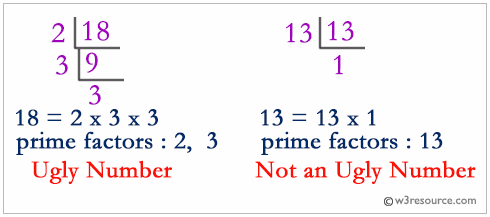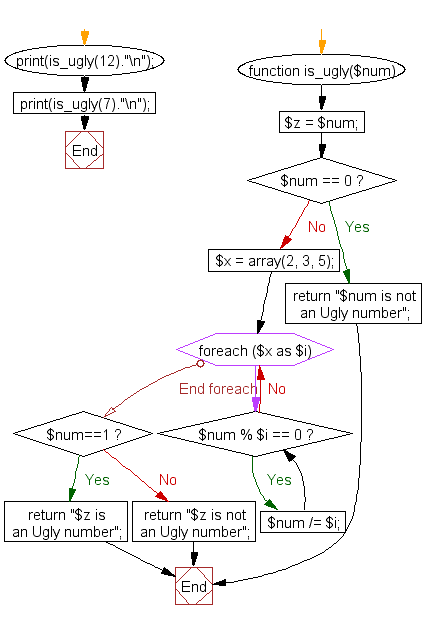PHP Challenges: Check whether a given number is an ugly number
PHP Challenges - 1: Exercise-19 with Solution
Write a PHP program to check whether a given number is an ugly number.
Input : 12
Ugly numbers are positive numbers whose only prime factors are 2, 3 or 5. The sequence
1, 2, 3, 4, 5, 6, 8, 9, 10, 12, ...
shows the first 10 ugly numbers.
Note: 1 is typically treated as an ugly number.
Explanation :

Sample Solution :
PHP Code :
<?php
function is_ugly($num)
{
$z = $num;
if ($num == 0)
{
return "$num is not an Ugly number";
}
$x = array(2, 3, 5);
foreach ($x as $i)
{
while ($num % $i == 0)
{
$num /= $i;
}
}
if ($num==1)
{
return "$z is an Ugly number";
}
else
{
return "$z is not an Ugly number";
}
}
print(is_ugly(12)."\n");
print(is_ugly(7)."\n");
?>
Sample Output:
12 is an Ugly number 7 is not an Ugly number
Flowchart:

PHP Code Editor:
Contribute your code and comments through Disqus.
Previous: Write a PHP program where you take any positive integer n, if n is even, divide it by 2 to get n / 2. If n is odd, multiply it by 3 and add 1 to obtain 3n + 1. Repeat the process until you reach 1.
Next: Write a PHP program to get the Hamming numbers upto a given numbers also check whether a given number is a Hamming number.
What is the difficulty level of this exercise?
Test your Programming skills with w3resource's quiz.
PHP: Tips of the Day
How to Sort Multi-dimensional Array by Value?
Try a usort, If you are still on PHP 5.2 or earlier, you'll have to define a sorting function first:
Example:
function sortByOrder($a, $b) {
return $a['order'] - $b['order'];
}
usort($myArray, 'sortByOrder');
Starting in PHP 5.3, you can use an anonymous function:
usort($myArray, function($a, $b) {
return $a['order'] - $b['order'];
});
And finally with PHP 7 you can use the spaceship operator:
usort($myArray, function($a, $b) {
return $a['order'] <=> $b['order'];
});
To extend this to multi-dimensional sorting, reference the second/third sorting elements if the first is zero - best explained below. You can also use this for sorting on sub-elements.
usort($myArray, function($a, $b) {
$retval = $a['order'] <=> $b['order'];
if ($retval == 0) {
$retval = $a['suborder'] <=> $b['suborder'];
if ($retval == 0) {
$retval = $a['details']['subsuborder'] <=> $b['details']['subsuborder'];
}
}
return $retval;
});
If you need to retain key associations, use uasort() - see comparison of array sorting functions in the manual
Ref : https://bit.ly/3i77vCC
- New Content published on w3resource:
- HTML-CSS Practical: Exercises, Practice, Solution
- Java Regular Expression: Exercises, Practice, Solution
- Scala Programming Exercises, Practice, Solution
- Python Itertools exercises
- Python Numpy exercises
- Python GeoPy Package exercises
- Python Pandas exercises
- Python nltk exercises
- Python BeautifulSoup exercises
- Form Template
- Composer - PHP Package Manager
- PHPUnit - PHP Testing
- Laravel - PHP Framework
- Angular - JavaScript Framework
- Vue - JavaScript Framework
- Jest - JavaScript Testing Framework
